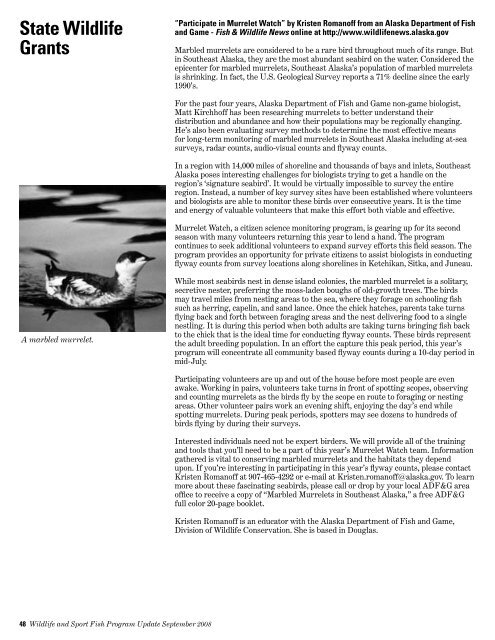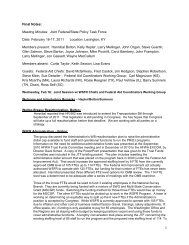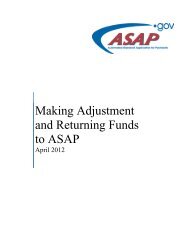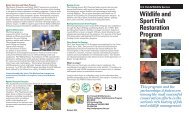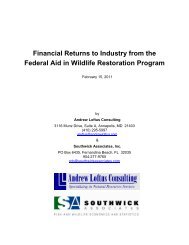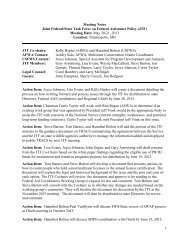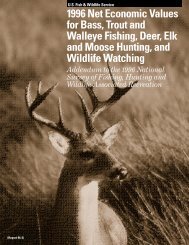Program Update - Wildlife and Sport Fish Restoration Program - U.S. ...
Program Update - Wildlife and Sport Fish Restoration Program - U.S. ...
Program Update - Wildlife and Sport Fish Restoration Program - U.S. ...
You also want an ePaper? Increase the reach of your titles
YUMPU automatically turns print PDFs into web optimized ePapers that Google loves.
State <strong>Wildlife</strong><br />
Grants<br />
“Participate in Murrelet Watch” by Kristen Romanoff from an Alaska Department of <strong>Fish</strong><br />
<strong>and</strong> Game - <strong>Fish</strong> & <strong>Wildlife</strong> News online at http://www.wildlifenews.alaska.gov<br />
Marbled murrelets are considered to be a rare bird throughout much of its range. But<br />
in Southeast Alaska, they are the most abundant seabird on the water. Considered the<br />
epicenter for marbled murrelets, Southeast Alaska’s population of marbled murrelets<br />
is shrinking. In fact, the U.S. Geological Survey reports a 71% decline since the early<br />
1990’s.<br />
For the past four years, Alaska Department of <strong>Fish</strong> <strong>and</strong> Game non-game biologist,<br />
Matt Kirchhoff has been researching murrelets to better underst<strong>and</strong> their<br />
distribution <strong>and</strong> abundance <strong>and</strong> how their populations may be regionally changing.<br />
He’s also been evaluating survey methods to determine the most effective means<br />
for long-term monitoring of marbled murrelets in Southeast Alaska including at-sea<br />
surveys, radar counts, audio-visual counts <strong>and</strong> flyway counts.<br />
In a region with 14,000 miles of shoreline <strong>and</strong> thous<strong>and</strong>s of bays <strong>and</strong> inlets, Southeast<br />
Alaska poses interesting challenges for biologists trying to get a h<strong>and</strong>le on the<br />
region’s ‘signature seabird’. It would be virtually impossible to survey the entire<br />
region. Instead, a number of key survey sites have been established where volunteers<br />
<strong>and</strong> biologists are able to monitor these birds over consecutive years. It is the time<br />
<strong>and</strong> energy of valuable volunteers that make this effort both viable <strong>and</strong> effective.<br />
Murrelet Watch, a citizen science monitoring program, is gearing up for its second<br />
season with many volunteers returning this year to lend a h<strong>and</strong>. The program<br />
continues to seek additional volunteers to exp<strong>and</strong> survey efforts this field season. The<br />
program provides an opportunity for private citizens to assist biologists in conducting<br />
flyway counts from survey locations along shorelines in Ketchikan, Sitka, <strong>and</strong> Juneau.<br />
A marbled murrelet.<br />
While most seabirds nest in dense isl<strong>and</strong> colonies, the marbled murrelet is a solitary,<br />
secretive nester, preferring the moss-laden boughs of old-growth trees. The birds<br />
may travel miles from nesting areas to the sea, where they forage on schooling fish<br />
such as herring, capelin, <strong>and</strong> s<strong>and</strong> lance. Once the chick hatches, parents take turns<br />
flying back <strong>and</strong> forth between foraging areas <strong>and</strong> the nest delivering food to a single<br />
nestling. It is during this period when both adults are taking turns bringing fish back<br />
to the chick that is the ideal time for conducting flyway counts. These birds represent<br />
the adult breeding population. In an effort the capture this peak period, this year’s<br />
program will concentrate all community based flyway counts during a 10-day period in<br />
mid-July.<br />
Participating volunteers are up <strong>and</strong> out of the house before most people are even<br />
awake. Working in pairs, volunteers take turns in front of spotting scopes, observing<br />
<strong>and</strong> counting murrelets as the birds fly by the scope en route to foraging or nesting<br />
areas. Other volunteer pairs work an evening shift, enjoying the day’s end while<br />
spotting murrelets. During peak periods, spotters may see dozens to hundreds of<br />
birds flying by during their surveys.<br />
Interested individuals need not be expert birders. We will provide all of the training<br />
<strong>and</strong> tools that you’ll need to be a part of this year’s Murrelet Watch team. Information<br />
gathered is vital to conserving marbled murrelets <strong>and</strong> the habitats they depend<br />
upon. If you’re interesting in participating in this year’s flyway counts, please contact<br />
Kristen Romanoff at 907-465-4292 or e-mail at Kristen.romanoff@alaska.gov. To learn<br />
more about these fascinating seabirds, please call or drop by your local ADF&G area<br />
office to receive a copy of “Marbled Murrelets in Southeast Alaska,” a free ADF&G<br />
full color 20-page booklet.<br />
Kristen Romanoff is an educator with the Alaska Department of <strong>Fish</strong> <strong>and</strong> Game,<br />
Division of <strong>Wildlife</strong> Conservation. She is based in Douglas.<br />
48 <strong>Wildlife</strong> <strong>and</strong> <strong>Sport</strong> <strong>Fish</strong> <strong>Program</strong> <strong>Update</strong> September 2008


